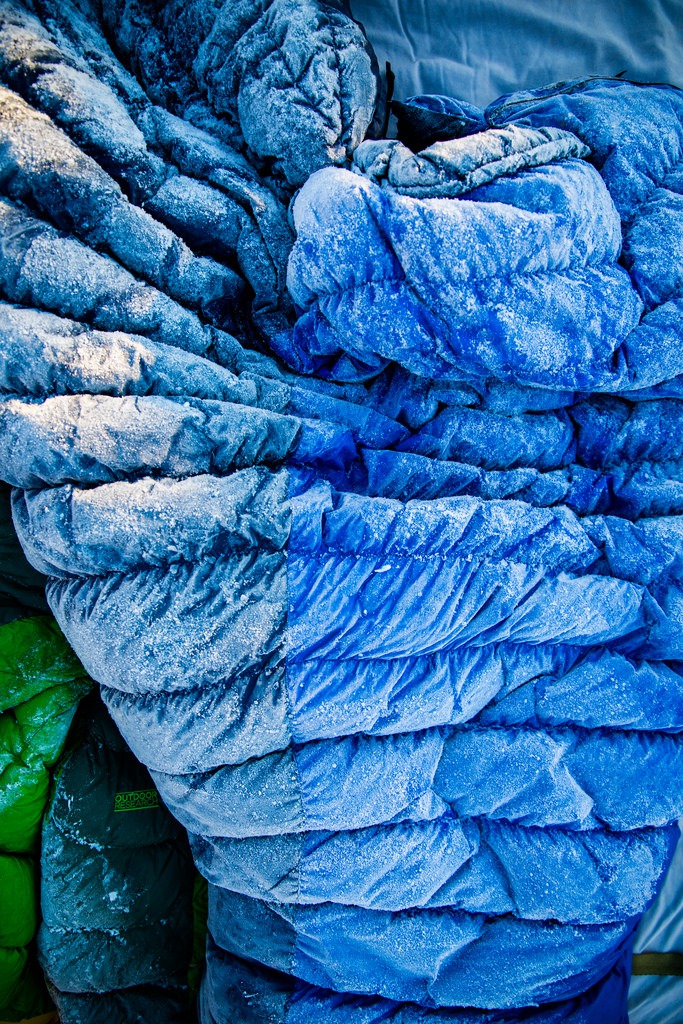Sleeping bags are expensive, and the right one could be with you for 20 years or more. Choosing the right sleeping bag is therefore quite an important decision.
Sleeping bags are also one of the big 3 items backpackers need: backpack, shelter, and sleeping bag (and pad.) They’re called the big three because they weigh a lot and their quality and performance can impact your experiences in a big way.
While shopping around for a sleeping bag, you will find yourself looking at a world full of options, which can be confusing.
Choosing the right sleeping bag will require you to strike a balance between multiple factors which I plan to walk you through completely in this article. After you have a better understanding about sleeping bags, we’ll jump into the core issue for this article: How to Choose.
So lets get stuck in:
Temperature Ratings and Warmth
Insulation Types
These days there are quite a few different types of insulation for sleeping bags:
- Goose down feathers
- Duck down feathers
- Climashield APEX (Synthetic)
- Primaloft (Synthetic)
- Cotton Core
Goose down, and Climashield APEX are currently the most prominent insulation materials being used in high quality sleeping bags. Which you choose will depend mostly on your climate and the expected length of your trips. Duck down is usually a cheaper alternative to goose down. Primaloft actually offers more warmth per weight than APEX but requires sewn-through construction to hold up durability wise, this is why you see a lot of primaloft in clothing with small panels and checkered patterns but will see more APEX in sleeping bags with large panels. Cotton core sleeping bags should be avoided. They’re essentially for hostel or car camping / glamping.
Down
Down is a natural material that grows as part of the feathery plumage of birds such as ducks and geese. It has a very fine texture in comparison to the normal feathers. Also, its spherical structure traps a good amount of air between the filaments.
Down padding material considerably offers more warmth than synthetic, irrespective of the fact that it is lighter in weight. It is also more comfortable, compressible and durable than synthetic insulation. This is one reason why more backpackers choose down sleeping bags for multi-day trips.
Its quality is calculated by its fill power and the cubic inches that are displaced by one ounce of the material. The higher the fill-power the less down fill is required to reach the same warmth levels. This results in a lighter, and more compact bag, for the same warmth. Going from 600 fill power, to 800+ fill power, you’ll see around a 25% reduction in bulk once compressed.
The downside to down is that it loses a lot of its insulating properties when wet, or even just damp from prolonged use in damp, raining, or humid conditions.
Hydrophobic Down
Hydrophobic down, is your usual down feathers that have been treated with a hydrophobic substance. This process is essentially just spraying down feathers and coating them with DWR. The jury is still out on how this will affect a sleeping bags long term durability.
The benefits are well known to be:
- faster dry times should you get your sleeping bag soaked by rain or river
- better performance while damp
The potential downsides people worry about is loss of durability or bounce back after spraying, there is a slight loss of about 50 fill power after spraying takes place but I’m yet to see evidence of long term damage caused by this.
Shell Materials
Shell materials have gotten a lot lighter in the last few years. You can now get a sleeping bag with as low as 10d ripstop nylon as its shell fabric. Personally I recommend not going lower than 20D. 20D is fairly lightweight and does require some care to be taken but its not like I have to worry about ripping it in my sleep like I would with a 10D shell.
Shape and Fit: Quilt vs Sleeping Bag
Sleeping bag shapes haven’t changed much over the last few decades, you can either choose a rectangular tube without an annoying hood, or a mummy bag with a hood, named as such because it looks like you’ve been mummified when you get into it.
Thankfully, there is a new kid on the block in sleeping bag design:
The quilt.
Sleeping bags are slowly starting to be phased out of the cottage industry in favor of quilts. Quilts, like sleeping bags follow the a similar pattern, but they don’t cover your back. Instead, they leave an opening where compressed down once lay flat doing nothing. This is really only possible with the advent of super lightweight sleeping pads that offer much more warmth than they used to. Its essentially like sleeping outside under a blanket, and unsurprisingly is a lot more comfortable than sleeping like a mummy in a mummy bag.
How To Choose
Choosing which sleeping bag you want to use on a hiking or backpacking adventure will come down to your trips location, expected rain, duration, and of course temperature. Once you have those criterion nailed down, then you can begin looking at weight and durability of materials. Finally, you can now choose out the correct length and width size that suits your body size and sleeping style.
So to begin,
Start with your trip’s expected temperature range:
Your sleeping bag should be rated to at least the lowest expected temperature on your trip. For example, if the lowest temperature you expect to see on a four day hike is 20f, you should choose a 20f rated sleeping bag. One caveat is, if you expect to see lots of 20f nights, you might prefer a 10f sleeping bag so you can ditch some clothes on the warmer nights and sleep more comfortably.
Also note, most temperature ratings expect you to be wearing at least a single layer of clothing or thermals, in order to sl-eep in my boxer shorts, I’ll choose a sleeping bag that lets me do that comfortably most nights even if it means I’m carrying a little extra weight.
Rain and trip duration:
If you expect a lot of damp wet days on most of your trips, for example, people in New Zealand or Scotland, you should consider a synthetic sleeping bag. It weighs more, but it’s also less affected by many nights of humid air and tends to dry faster in those short bursts of sunny weather you might see.
If you expect a lot of dry sunny weather on most of your trips, stick with a down sleeping bag, its much much lighter, and lasts a log longer.
Wet or dry, if the majority of your trips are short weekend 2-3 day trips, I suggest sticking with down, or at least hydrophobic down. It takes at least 4-5 days of damp weather before down sleeping bags will really start to loose their loft.
Weight & Materials:
The weight of the sleeping bag will mostly be affected by fill type (down vs synthetic), and secondly affected by shape or bag type (backpacking quilt vs sleeping bag.)
Down will obviously be lighter, but if you have no choice, a good synthetic sleeping bag is perfectly acceptable, especially if it is made out of Climashield APEX. One thing of note is that while down sleeping bags, with care, can last upwards of 20 years, where synthetic fillings usually breakdown after a few (2-3) years of compression and recomression. Note: Through hikers you’ll be lucky to get more than a full PCT out of either type although down is much more likely to survive a second go round.
Size & Side vs Back sleepers
Sleeping bags will usually come in two lengths (regular and long), and two widths (regular and wide).
Regular will usually fit someone up to and including 6′, and long is usually required for anyone over that. I’m 6’1″ and fit into some regular bags but it is often a tight fit around my chest and usually prefer how the long version feels. This leaves a lot of space free at the bottom of my sleeping bags, I’ll either dry some clothes out in the space or pull it up and roll the top end down giving me double thickness up top.
A wide should be considered for larger builds and anyone who feels claustrophobic in a normal sleeping bag. Wide sleeping bags will also give a lot of free space to work with for those people who roll around a lot.
Side sleepers vs back sleepers vs stomach sleepers. I’m a side sleeper and for this reason I will generally prefer a long sleeping bag without a hood which gives me a bit more room to curl my legs up and there is no hood to get in the way when I’m tossing and turning at night.
Some cottage industry manufaturers who make custom sleeping bags to order, will offer many many more sizing options. One of which I will happily recommend is Enlightened Equipment. EE mostly makes quilts but do have a hybrid sleeping bag + quilt called the convert.
Recommendations
You might like to take a look at some of these in depth product reviews for:

